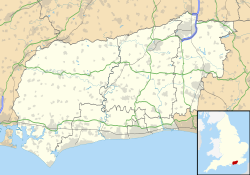| St Wilfrid's, Burgess Hill | |
|---|---|
| Saint Wilfrid's Roman Catholic church | |
 Saint Wilfrid's church | |
| 50°57′13″N0°08′04″W / 50.9537°N 0.1345°W | |
| Location | Burgess Hill, West Sussex |
| Country | England |
| Denomination | Roman Catholic |
| History | |
| Founded | 1940 |
| Dedication | Saint Wilfrid |
| Administration | |
| Diocese | Roman Catholic Diocese of Arundel and Brighton |
St Wilfrid's Church is a Roman Catholic church in Burgess Hill, West Sussex.
A former Congregational chapel in Grove Road served as Burgess Hill's Roman Catholic church until St Wilfrid's was built by a local firm in 1940. Frank Brangwyn provided the Stations of the Cross and Joseph Cribb, a pupil of Eric Gill, carved the statue of Saint Wilfrid above the entrance. [1] [2]
It is part of the Diocese of Arundel and Brighton.
It is associated with St Wilfrid's Catholic Primary School.

